Hornby Island Blues Workshop
2025 Workshop Descriptions
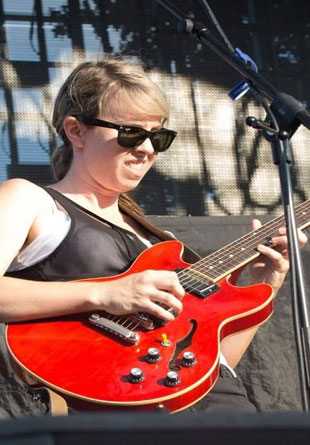
Emily Burgess - Guitar
Major: Speak that Musical Language
We all know that blues is about feeling, but an understanding of music theory can actually enhance your ability to present that expression from within onto your guitar. Connecting theoretical knowledge to your ears can give you that ‘aha!’ moment and a big picture appreciation for the blues. In this course, we will learn music theory with both our eyes and ears, and most importantly, we will apply this learning to songs, riffs, and everyday blues situations. The goal is the increased internalization of musical knowledge that can help you grow exponentially as a musician.
Monday Minor: The Swingin' Guitar of Hollywood Fats
Michael Mann a.k.a 'Hollywood Fats' was given his stage name by Buddy Guy and Junior Wells. In the world of blues guitar, he sits high up among the greats. His mastery of phrasing, impeccable swing feel, and bold comping style are just a few qualities that make his guitar playing iconic. In this course, we will analyze his playing style, and pull important lessons from his solos and rhythm work. Hollywood Fats died at a young age and released just one album under his own name: 'Hollywood Fats Band'. As countless studied blues musicians have done since its release in 1979, we will use this album as a guide and resource to top-tier blues playing.
Tuesday Minor: The Bo Diddley Beat
If you listen to music, you have heard it before - the ‘Bo Diddley Beat’. In this minor class we will learn about Bo Diddley, his signature rhythm and its origins. Once we have learned and established the beat, we will explore how to include higher-up guitar chords and lead riffs while still holding down the rhythm. Join this class to get an introduction to an incredibly fun jamming tool for both solo guitar practice and group playing.
Wednesday Minor: The Many Uses of your Bottom 3 Strings
How often, when it’s your turn to solo, do you immediately jump up to the high notes on your guitar? It makes sense, because it’s a solid way to make your presence known as a soloist. While there is a lot to be said on those higher strings, this class will shine a light on the bottom 3 strings of the guitar and the creative ways we can use them in our soloing and comping. Making use of the full dynamic range of the guitar neck can add dimension to your playing and turn some heads!
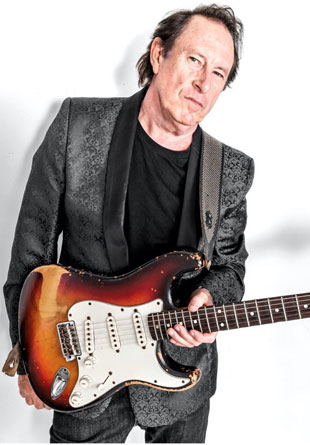
Jack de Keyser - Guitar
Major: BB KING. Play Like a King
We will learn as many BB tunes and grooves as we can in this major.
Learn the essential BB licks, the BB King favorite neck positions, how to make less- more, and
How to bend and vibrato notes. We will learn a few jazz/blues chords- BB did not play chords to serve as accompaniment, and learn the turn arounds to each song.
We will cover these songs in a class that will be fun and feature lots of class improvising over 12 bar blues and teach you how to be a better improviser and play with more feel.
Everyday I Have the Blues.
Woke Up This Morning.
Sweet Little Angel.
Please Love
Rock Me Baby.
Thrill Is Gone.
How Blue Can You Get?
Monday Minor: Slide By.
This class will teach you the 3 most popular slide tunings. We will learn a tune or 2 in each tuning. **Bring a slide!
Standard Spanish tuning: Muddy Waters; You Shook Me. Duane Allman; Statesboro Blues.
Open D: Elmore James; Dust My Broom.
Open G: Robert Johnson; Terraplane Blues , Walking Blues.
Tuesday Minor: Rhythm, Riffs, and Reed-Jimmy Reed.
Jimmy Reed wrote more blues hits than anyone. We’ll learn the classic 2 guitar interplay of Jimmy’s most beloved tunes; Baby What You Want Me To Do (Peepin n Hidin), Big Boss Man , Bright Lights Big City, Ain’t Got You. Learn some great turn arounds, riffs and rhythms!
Wednesday Minor: Howlin’ For My Darling.
We’ll learn 3 or 4 or 5 of the Wolf’s (And Hubert Sumlin’s) greatest riffs during this class. Killin’ Floor, Ain’t Superstitious, Smokestack Lightning, Spoonful, Red Rooster (Bring slide). A fun class with lots of jamming.

Angel Forrest - Vocals
Major: The Fabric is in the Details
Let's hear how high you can soar
How raunchy you roar
And how deep you can growl
Comfort and flexibility in your delivery are a must and come from
Knowing your tools ability
Knowing what keys work best... no one gains when one strains.
We're gonna find your sweet spot!
.
Monday Minor: Teach the World to Sing
in this minor class we will learn and execute turning a pop song into a blues... and maybe just maybe perform it for our peers.
Tuesday Minor: Sound of the Angels
Harmony is moving and magical...
In this minor class Denis will take the reins and share his knowledge for the fundamentals of harmonizing... and believe me he is a master. A good harmonizer behind every singer is GOLD!
Wednesday Minor: Playing Nice to Inspire

Brandon Isaak - Guitar
Major: The Electric Blues Guitar
We’re going to do a comprehensive study of everything between an electric guitar and the Blues. We'll look at soloing, chords, classic riffs and licks and the right attitude to be the best no matter how good you are. This will be fun and we’re going to dig deep and all learn a lot. When our 3 days are over, you'll be playing solos with more soul, better story lines and more conducive and complimentary to the song.
Monday Minor: Being a Band Leader
Leading a band, how to talk to an audience, how to perform a song with a band you don’t know. After this, you'll be able to get on any stage and sound good while leading your band.
Tuesday Minor: Writing Better Songs
How to dress a song, finding the mood for the lyrics, strengthens your song writing muscles and keeping it simple. You will leave this class with more confidence and better songs writing skills.
Wednesday Minor: Art of the Guitar Solo
We'll look at how to build a solo, how to take it through dynamics, some great riffs, tips and tricks. You'll never play a solo the same!
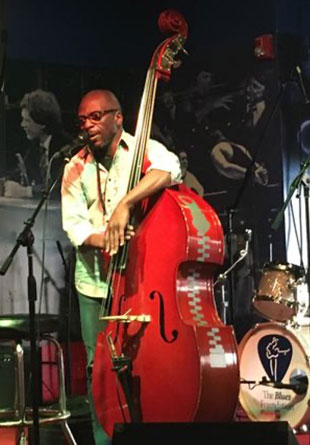
Russell Jackson - Bass
All classes are for Beginners to Advanced Players
Major: Terminology (Lump, Bump, Swing, Quick 4s etc.)
Bass players to listen to. Start positions. How to shuffle. Quarter notes.
Monday Minor: Different Forms (8 bars, 12 bars, 24 bars, etc.)
Major and Minor. Funk Blues. Slap Bass Blues.
Tuesday Minor: Stand-up Bass Style (1 hour)
How to control rhythm sectons. Tone control.
Wednesday Minor: Playing in a Band
How to promote yourself. Get connected.
Bass etiquette.
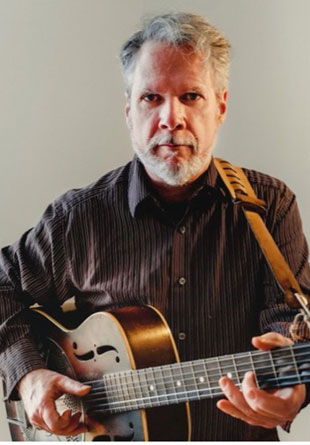
Michael Jerome Browne - Guitar
Major Class: Down-Home Texas Blues (For Intermediate and Advanced players).
Mississippi Delta Blues is more famous, and Piedmont Blues is seen as the other side of the coin, but Texas Blues offers another approach, and it’s had a strong impact since the earliest days. In this class we will dive into early Texas Blues, with that thumpy single note bass and other techniques. Our goal will be to get that muted bass going, while letting the treble strings ring. We will briefly touch on Blind Lemon Jefferson, then move on to Mance Lipscomb, J.T. “Funny Paper” Smith (The Original Howling Wolf), Li’l Son Jackson, and culminating in Lightnin’ Hopkins. (Note: we will NOT be studying Albert Collins, Johnny Winter, or SRV).We will work mainly in standard tuning. Students should have a basic understanding of either alternating thumb bass or single note bass techniques.
Monday minor: Robert Johnson Overview (Intermediate)
Robert Johnson is one of the most popular and influential guitarists in the blues today, despite relative obscurity in his lifetime. In this class we will do an overview of the 29 songs he recorded, looking at tunings and keys and who his influences were; then we will settle into his playing in standard tuning (we won’t focus on slide). We will learn a few right-hand riffs and turnarounds that recur in many of his songs, regardless of key. These riffs will help unlock his playing.
Tuesday minor: Turnarounds 1- Jamming (All levels)
Turnarounds (the last two bars of a blues progression) are perhaps the most important part of playing the blues. They are the glue that holds a performance together. Unfortunately there are many, many different ones, and some songs don’t actually have one! In this introduction we will look at the variety of turnarounds in different regional styles (Mississippi/Chicago, Texas, New Orleans, East Coast), both pre- and post-war. The goal will be to learn how to listen for turnarounds in a jam situation and to figure out how some turnarounds fit with others. There will be jamming!
Wednesday minor: Turnarounds 2- Fingerstyle (Intermediate and Advanced)
Turnarounds 1 is not a prerequisite for this class. This one is for fingerstyle players interested in exploring turnarounds used by the early acoustic players. We may also make up a few of our own!
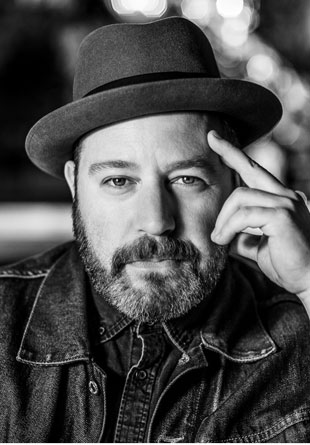
Steve Marriner - Harmonica
Major Class: Blues Harp - The (Ten) Hole Story
Skill Level: Beginner to Advanced
I
n this workshop, we’ll explore all aspects of this small, but mighty instrument. We will cover everything from fundamentals such as: grip, embouchure, single notes and chords to more advanced techniques like: bending notes, tongue blocking, throat vibrato and much more!
It will feature an in depth look at the origins and history of the harmonica and how the unique styles of the masters of blues harp have influenced generations of players.
We will also discuss which microphones, effects and amplifier combinations players can use in their quest for their own, distinctive harp tone.
Finally, students will learn practical applications for all of this new knowledge in their approach to playing blues.
Monday minor: Expanding Your Vocabulary: The Different Positions of Blues Harp
Skill Level: Beginner to Advanced
Expanding Your Vocabulary: The Different Positions of Blues Harp
How does the key of the harmonica versus the key of the song change your vocabulary on the instrument? Everybody has heard of ‘cross harp’, but what about first and third position? As we take a look at the theory of blues harp, find out new ways of playing harmonicas in different keys to create different moods within the song.
Tuesday minor: Tongue Twisters
Discover the many tips, tricks and techniques employed by the strongest muscle in your body!
We’ll take a closer look at tongue blocking for single notes, octave splitting, trills, flutters and warbles to add some exciting new sounds to your harp playing.
Wednesday minor: I Hear That Train a Comin'
Skill Level: Beginner to Advanced
There’s more than one way to make that lonesome whistle blow, and in this workshop, we’ll explore the rhythmic side of the blues harp. Make it wail, chuck and chug as we examine the incredible contributions from country blues harp legends such as Sonny Terry, John Lee Williamson and DeFord Bailey.

Chris Nordquist
Level: All levels welcome
Major: Coming up the River
(From New Orleans to Chicago)
Monday Minor: Shufflin (finding the right one for the tune)
Tuesday Minor: Playing in the Pocket. (when to play fills and when to ride with your pony)
Wednesday Minor: Different feels, tempos.
How to lead the band and how to follow.
Having Fun!!!!!

Ndidi Onukwulu - Songwriting
Major: Origins of the Blues
In this class we will learn and discover the historical origins of the blues and explore writing themes both traditional and modern. I will then teach writing structure and vocal techniques most associated with blues music and we will explore how to resonate with the blues and create a performance that is unique to you and your one of a kind voice/style.
We will then look at blues singing and musical styles and explore the differences and commonalities. The students will be then encouraged to participate in deciding what style of blues resonates with them the most and we will then as a class in small groups begin to workshop and write original songs.
Monday Minor - History of the Blues
We will look at origins, key players and what music the blues transformed into and then look at common themes and singing styles
Tuesday Minor - Blues Songwriting Formats
We will look at blues songwriting formats and begin to work on original writing in small groups
Wednesday Minor - Songs Workshop
We will workshop the songs we have written and work on collaborative performance techniques.
PLEASE NOTE: The students will need to be provided paper and pens if they have guitars or percussive instruments even better they will just need to bring themselves and a willingness to learn and play, it might be called the Blues but trust me it’s a lot of fun. I will plug my phone/computer into a speaker to provide musical aid/visual aids when necessary.
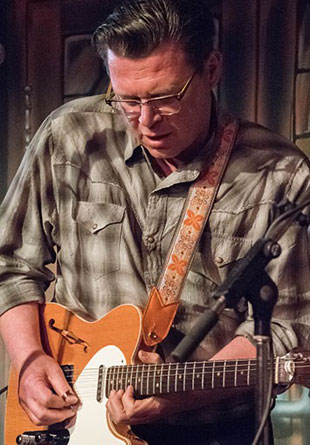
Paul Pigat - Guitar
Major: Ragtime Guitar 101
I’ve taught a lot of finger style courses at the Hornby Island blues camp so why stop now?
This year we will take a slightly different path however. Let’s go back to the roaring 20s and explore Ragtime guitar! Ragtime was a big influence on many early acoustic blues players and is an essential sound to have in your toolbox to be a well-rounded finger style guitarist. We will look at a few simple pieces to get you started in your exploration of this exciting style of playing! Acoustic guitars preferred for this one!
Monday Minor: The Genius of Scotty Moore
What’s more to say than that? They don’t call his solo from “that’s all right mama” the guitar that changed the world! Let’s check that one out and maybe a few more.
Tuesday Minor: Substitutions in the Blues!!
A lot can be done in the space of 12 bars!!! Let’s take a simple blues and start adding chords till we get to a whole new place. We will look at chords used by both blues and jazz musicians to spice up this traditional form!!
Wednesday Minor: Arpeggios
Scales are cool but arpeggios are cooler! It’s a great way to add a new colour to your playing and combining them together really takes your playing to the next level!

Steve Strongman - Guitar
Major: Finding your Signature Sound - Bends, Vibrato and Pentatonics
What do all the greatest guitarists have in common? You know who it is after just a few notes….BB King, Freddie King, Clapton, Hendrix, Wes Montgomery, Joe Pass, Mel Brown…the list goes on. We all use the same notes, yet the greats make them their own. How?
Monday Minor: Countrified Blues
This class will explore country tinged blues licks and beyond. From Travis Picking, to Chickin’ pickin’, to straight up burnin’ blue grass pickin’ …all built on the foundation of the blues.
Intermediate, Advanced
Tuesday Minor: The Depth of the Slide
(Intermediate, Advanced)
Explore the depth of adding the slide to your playing toolbox. Whether using Open or standard tuning, or exploring fretted notes behind the slide, the power of the slide will shine through and open your musical ideas.
Wednesday Minor: The Ocean of Songwriting
Let’s explore some of the ideas and techniques that go into songwriting - and how different artists go about writing (and finishing) a song….and what makes a great one. We will also discuss understanding the building blocks of songs, and how to tear them down.
Dawn Tyler Watson - Vocals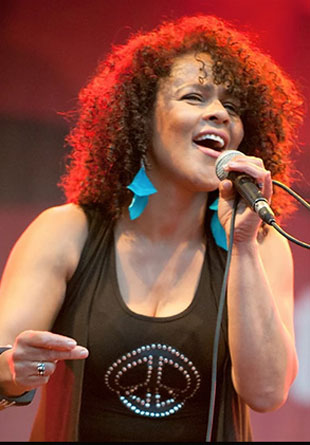
Major Class: Vocal Expression & Performance (Intermediate - Advanced)
In this PLAYshop, we’ll explore how to sound, look & feel your best in front of an audience. We’ll delve deeper into getting to know the various facets and nuances of our own unique voice, and focus on letting go and having fun through improvisation. We’ll address performance anxiety & stage fright, and we’ll discover how in trusting ourselves and our innate talent, we become connected; with ourselves, with others, and with the message of the song, making for more authentic and powerful performances.
*Please wear comfortable clothing for all classes And be ready for some light movement. Also bring a notebook and pen to jot down insights and observations.
Monday Minor: Vocal Basics (Beginners +)
In this workshop we’ll focus on the basics of singing...how to warm up and cool down. Proper posture, breath control, and support of the voice. Sound placement, tone, and how to project. All the Do's & Don'ts of singing.
Tuesday Minor: Gospel FUNshop (Open to all)
Come experience the joy of singing together in community. We'll learn about how the African American experience gave birth to the Blues. How the spirit of this music can help us get through hard times and find hope through the power of song!
Wednesday Minor: Stage Works (Open to all)
We’ll cover everything you’ll need to know about the workings of singing onstage (as opposed to in the shower!) Mic technique, negotiating your stage sound, communicating with your musicians and with the audience, and getting comfortable with movement on stage. (What do I do with my hands?!)
David Vest - Piano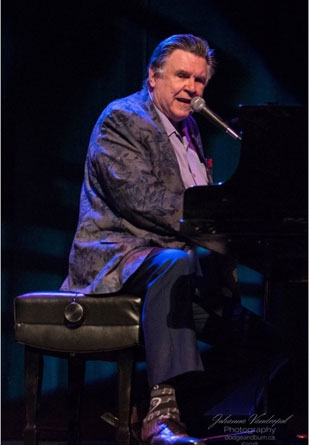
Major Class: Blues Piano
This is a hands-on workshop. Everyone is welcome, but folks who can already play a bit will get the most out of it. Blues piano playing is fun, and boogie-woogie playing is over-the-top fun, so we'll spend time on both. We'll learn several essential boogie-woogie left-hand patterns, along with a handful of classic blues licks for both hands.
Apart from the basics, if you have some specific things you're hoping to learn, you'll get a chance to ask about them and we'll work on them for sure. Otherwise, your instructor will just suggest a bunch of different patterns for you to play, make sure everyone understands them, and then we'll just jam away.
We'll look at how to play solo and also how to play with others, which includes not only soloing but comping and playing fills and turnarounds.
In addition to your keyboard (and amp if needed), bring some headphones (cheap ones are fine). There may be times when you want to linger over something while the class is playing something else.
Monday Minor: Playing Ray Charles-style piano (combining blues, rock, jazz, and gospel elements).
Tuesday Minor: Classic rock piano styles (Jerry Lee Lewis, Fats Domino, Little Richard, Johnny Johnson)
Wednesday Minor: Playing as an accompanist (to yourself or someone else)
We'll look into the work of great piano sidemen and women -- Otis Spann, Blind John Davis, Mildred Falls and others -- and uncover the secret of how to play with someone when irregular time makes them hard to follow.
Ted Tanner - Community Liasson
Always an engaging musical presence, Ted’s Tanner has seasoned and honed the craft of a well-delivered song on stages and streets around the world. He has 25 years of playing music professionally under his belt, joining forces with many creative projects along the way, and as a professional solo artist, busker and consummate troubadour. For the last 13 years Ted has been living and performing on and around Hornby Island, directing much of his musical and creative energies as a guitarist & singer with local favourites, The Rudiments roots rock reggae band. His diverse musical palette includes a lifelong passion for the blues, but no matter what he plays you can count on it delivered with heart & soul.
Ted will be offering private lessons, doing Blues in the Schools, Thursday performance at The Coop, and Opening night playing with Gordie and friends.
For more information:
Hornby Island Blues Society
3500 C Shingle Spit Rd
Hornby Island BC
Canada V0R 1Z0
Email: info(at)hornby-blues(dot)bc(dot)ca